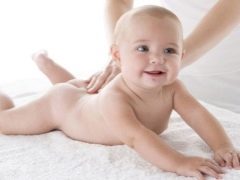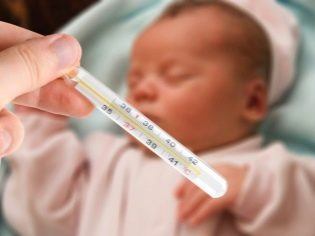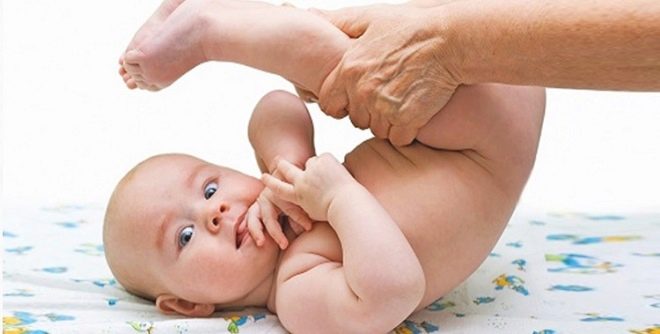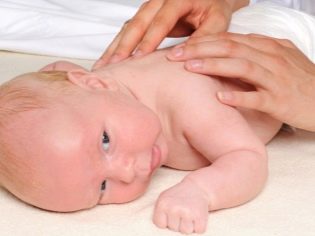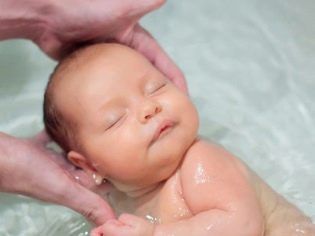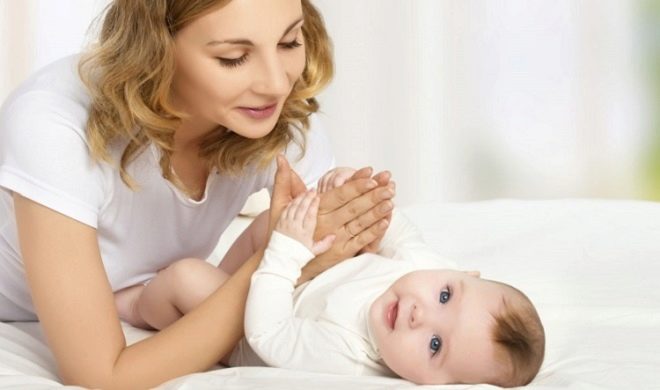How to massage the baby at home?
The child spends nine months in the close space of her mother's womb. There, he (especially in late pregnancy) has no way to straighten his limbs, stretch, straighten. That is why all babies from birth have physiological problems with muscle tone. Massage is designed to help parents quickly cope with it, as well as to promote a more harmonious physical development of the baby. How to make it to babies independently, we will tell in this article.
Benefit
Some people think that massage is prescribed only to those babies who have certain health problems. This is of course true. But the general massage is shown to all children, even perfectly healthy. If we consider that the sessions performed by a professional massage therapist are quite expensive, the question of how to make a massage independently does not lose its relevance.
In the first year of their life, an infant develops by leaps and bounds. It took several thousand years for humanity to rise to its feet and walk with support for two limbs. The nature of the child takes no more than a year to this. From a helpless lump, he quickly turns into a man erect. Each of the stages of this "evolution" needs the support of adults. Learning to hold your head, turn over on its side, sit, crawl and walk - the primary tasks of the baby. Parents can help him in this.
At the very early stage of development, massage helps to eliminate the physiological tone, the baby gets the opportunity to grow and develop more freely. Starting from 3 months, the procedure is designed to strengthen the muscular frame so that the first turns and attempts to crawl in the baby get the best possible way. At any age, massage improves blood circulation, and also has a beneficial effect on the nervous system of the baby: it allows you to “invigorate” an inactive child and has a calming effect on the hyperactive baby.
Massage is also a great way to communicate between mother and child. Have you ever thought about why babies so often cry when they are touched by a stranger with a masseur's diploma? The answer is obvious: the child needs tactile contact, but not with anyone, namely, with the mother, whom he learned to feel during his existence in the womb.
Only a mother can turn an ordinary treatment-and-prophylactic procedure into a fun and exciting game that will bring not only body benefits, but also joy. Only mother knows how to feel her baby, the slightest nuances and shades of his mood, and therefore only she can choose the most suitable time for a massage session.
Professional massage is irreplaceable, but only in those cases if the child has congenital pathologies of the musculoskeletal system, birth trauma, paralysis and paresis, other diseases that require specialized procedures aimed at specific muscle groups. A healthy baby needs a general, classic massage, which any mother can easily master. A properly conducted session improves sleep, increases appetite, has a positive effect on the mood and well-being of the infant, and also helps strengthen his immunity along with bathing, walking, hardening, and vitamin therapy. It is the strengthening of the immunity of the baby - the most important task of each mother.
Contraindications
With all the obvious benefits, massage can hurt the baby, therefore, in some conditions and diseases, it is not recommended.
- Fever. If the child has a fever (got cold, teething, etc.), then an increase in blood circulation during a massage session may lead to an even higher temperature.
- Infectious diseases. Any ailments that are associated with the appearance of skin blisters, pustules, fungal, viral or bacterial rash are a strict and direct contraindication. Movement of the massage therapist can violate the integrity of the rash, infection of adjacent skin areas can occur.
- Non-infectious skin diseases. The development of prickly heat, skin allergies, diaper rash, as well as scratches and abrasions, burns are also a contraindication for massage, so the procedure can be performed only after the skin naturally regains its integrity.
- Heart defects. Disruption of blood circulation in a child born with heart disease, can occur even in complete rest. Massage is a certain load on the body, and no one can predict how a small heart will perceive it. For children with heart defects, massage procedures are done exclusively by specialists under the vigilant supervision of a cardiologist.
- Diseases of the blood and blood vessels. Some blood disorders and fragility of blood vessels create the risk of internal bleeding during a massage. This procedure is prohibited for hemophilia, hemorrhage, and for some congenital diseases associated with impaired hemostasis.
- Tendency to convulsions, epilepsy. Such infants massage is contraindicated because of the risk of provoking a new convulsive seizure.
- Large hernia. This is a common at an early age umbilical and inguinal hernia. If it is quite large and parts of organs come out into the hernial sac, veins, massaging can result in muscle contraction, which can, in turn, lead to the incarceration of the hernia.
In addition, with great caution should be addressed the issue of massage for a premature baby. Such sessions are not contraindicated for him, but the procedure may be postponed for a while (until the child reaches a certain body weight). For such babies, the question of when to begin the massage is decided solely by the pediatrician.
Age restrictions
Regarding the age at which you can begin to do massage, pediatricians do not have a consensus. Some doctors recommend healthy children to begin such sessions with a month and a half, others say that you can begin to massage immediately after the healing of the umbilical wound.
Modern pediatricians are more inclined to the second option: a child who does not have the above contraindications, you can and should begin to do a general classical massage from just 2-3 weeks of age, with the obligatory condition that the umbilical wound was completely delayed. For a two-month and three-month-old baby, massage should be an important and integral component of daily exercise along with washing, bathing, walking, feeding. You should not give up the massage and a seven-month or eight-month-old child, because at this age a new motor skills appear in the child, for which a strong and developed muscular system is required.
In any case, before starting a massage, a child of any age up to one year old should definitely ask for the opinion of the attending physician on this matter. So it will be quieter and mom and doctor.
Types of massage
Massage for infants can be fortifying, relaxing, relaxing, as well as tonic. All these types of massage belong to the group of classical massage. It can be done at the clinic if you are ready to visit it daily with your child, since it is undesirable to interrupt the course. It is much more convenient to do a massage at home. A specialist who comes to your house for a fee is quite expensive. If a completely specific type of therapeutic massage is not appointed, then such expenses are not necessary.
Classic massage techniques are based on the impact in three successive stages. At the first stage, strokes are made that adapt the skin of the child and his nervous system to subsequent manipulations. At the second stage, rubbing takes place, then kneading takes place. Complete the session again with gentle and delicate strokes.
There are also quite simple and very useful highly specialized types of massage: vibratory (children's percussion) - massage, which facilitates the discharge of sputum for bronchitis and other diseases of the upper respiratory tract; There is dacryomassage, which helps infants suffering from dactriocystitis (inflammation of the lacrimal sac).
Technique of
To master the technique of massage for babies is easy. This can be done even during pregnancy at special courses for expectant mothers who work in every antenatal clinic. After giving birth, you can consult a pediatrician or a nurse in the nursery, who will show you the basic techniques and techniques. In the end, in the 21st century, it is quite possible to use video tutorials that are abundant on the Internet. We describe in more detail the basic technique of some types of massage at home.
Tonic
Massage should begin in the supine position. After careful stroking the tummy should proceed to a massage of the limbs. First, the pens are massaged; for this, the mother fixes one handle in her, and with the other hand gently rubs the baby's handle from all sides. Then the second handle is massaged similarly. One leg is lifted and fixed by hand for the ankle, the second hand is carried out by stroking movements, and then slack rubbing, after which they repeat the same with the second leg.
The tummy is massaged with light movements in a circle. The second part of the session is performed in the prone position. Massaging the back muscles, but not affecting the spinal column, then perform stroking and light rubbing of the lateral muscles.
Tonic
A distinctive feature of toning firming massage is the use of innate children's reflexes. In the position on the side, fingers are held along the spine so that the baby unbends the back, and in the position of lying on the tummy, the legs are laid down and the palm is supported under the feet. After a slight translational movement with his palm, the baby will reflexively make a crawling movement.
If the child is more than four months old, you can add a light massage of the neck area and shoulder girdle. It should be done very carefully and limited to strokes and light rubbing.
The zone adjacent to the vertebrae, knead at home is prohibited.
Relaxing
Relaxing massage is based on soothing and gentle strokes, intensive kneading of muscles is not performed. The order of massaging coincides with the above: limbs, abdomen and chest, back, lateral muscles. You can complete the massage with circular strokes of the scalp and feet. Massage for relaxation is carried out before bathing, while it is important to ensure that the child is not over-excited while performing the complex. You should never combine a relaxing massage with a gymnastic exercise or exercise therapy, as the effect will be the opposite.
With bronchitis
Vibration (percussion) massage helps the child to quickly deal with a wet cough, accompanied by the formation and discharge of sputum. The child should be placed on the stomach through the knee of an adult. The tips of the chest and rib part are made by the fingertips both from the back and on the sides. After this, the baby is turned into a vertical position and lightly tapped on the back so that it coughs.
This massage is very useful at the final stage of viral and other diseases, when the cough becomes wet and you need to quickly remove the remnants of bronchial secretions. The procedure takes about 10 minutes.
With colic
If the baby is suffering from colic, you need to massage the stomach. Lay the child on the back, with the thumb the adult makes light circular movements around the navel in a clockwise direction. Then the child laid out on the tummy for 10-15 minutes. Such a session helps to divert intestinal gases, which are the cause of colic, and alleviates the condition of the child. For greater efficiency, combine massage with other methods: applying a warm diaper, ironed with an iron, or a heating pad, as well as taking simethicone-based products.
With dacryocystitis
Children with dacryocystitis are massaged to release nasolacrimal ducts from pus and fluid. To do this, the mother holds her clean thumbs from the corner of the baby's eyes towards the bridge of the nose 8-10 times with a slight pressure. This allows you to restore the patency of the nasal pathways and facilitate the abduction of tear fluid. Massage products for the procedure are not used.
General rules
To massage procedure benefit, follow the general rules of its implementation:
- It is best to massage the child in the morning, as a massage before bed can cause nervous system agitation and sleep disturbances;
- you should not massage in a too hot room, the air temperature should not exceed 22 degrees;
- also pay attention to the humidity of the air - a humidity of 50-70% is considered normal;
- all the massage products that the mother is going to use for the massage should be hypoallergenic and allowed to be used in breastfeeding, while avoiding products with a strong aroma or pronounced color - perfume and dyes will not benefit the child;
- make the procedure on a hard and level surface, a changing table or a regular table is best suited for this purpose;
- Prepare in advance and arrange everything that you need during the massage, at arm's length, so that even for a second you do not turn away from the child and leave him alone on the table (otherwise, a soothing or tonic massage can turn into a fall and receive a serious injury);
- massage with clean and warm hands, as touching cold hands is unpleasant for children;
- try to do a massage after 45 minutes after feeding or one hour before the upcoming feeding (this way you can avoid regurgitation during a session or a hungry cry);
- increase the time of the procedure gradually and consistently (start with 3-4 minutes, gradually increase the time and bring the session to 15 minutes);
- do not waste precious time, use it sensibly and with maximum benefit - turn on the child music during manipulations, sing a song for him, read verses or counting; in parallel with the muscles, the baby will develop hearing, vision and speech perception;
- if the child cries during the session, is naughty, there is no point in continuing the impact, since there will be no benefit from such a massage (you should stop manipulating and hold the session at another time when the child is healthy, cheerful, cheerful and happy with everything).
Opinion of Dr. Komarovsky
The well-known pediatrician Evgeny Olegovich Komarovsky strongly recommends that mothers master a firming and soothing massage on their own and only in extreme cases seek the help of professional masseurs. Such situations include therapeutic manipulations, especially if you cannot hold them at home (for example, a massage is prescribed in combination with electrophoresis). In order to achieve maximum benefit, Evgeny Olegovich advises not to limit oneself to a massage, but to comprehensively strengthen children's immunity: Combine massage with hardening, cool baths and compulsory outdoor walks in any weather.
Useful exercises, gymnastics, exercise on fitball (from 6 months). But in all everything you need to know the measure, so between courses of massage you need to take breaks - for 1-2 weeks.
Reviews
Independent massage for most moms is easy. Already from the second or third procedure comes the exact understanding of what is being done and why. Some mothers in their reviews complain that the child's temperature rises after a massage. If this happens, it is possible that the manipulations were too intense, the blood circulation increased and led to an increase in temperature. It is necessary to reduce the load on the children's body, to do a soothing massage, which is more delicate.
Some mothers claim that home massage helped their babies not only quickly enough to get rid of hypertonia, but also, on the whole, markedly improved the state with low hemoglobin, with delayed speech or psychophysical development.
Most mothers agree that finding a good specialist in infants' massage at home is not easy. Now it is very easy to encounter amateurs - people who do not have a medical education at all, which does not prevent them from advertising their services and finding clients. Such people can harm your child and at the same time will not bear any responsibility. Already for this reason it is worth mastering simple massage techniques on your own.
About what are the types of massage, how often and why to do it, will tell Dr. Komarovsky in the next video.
